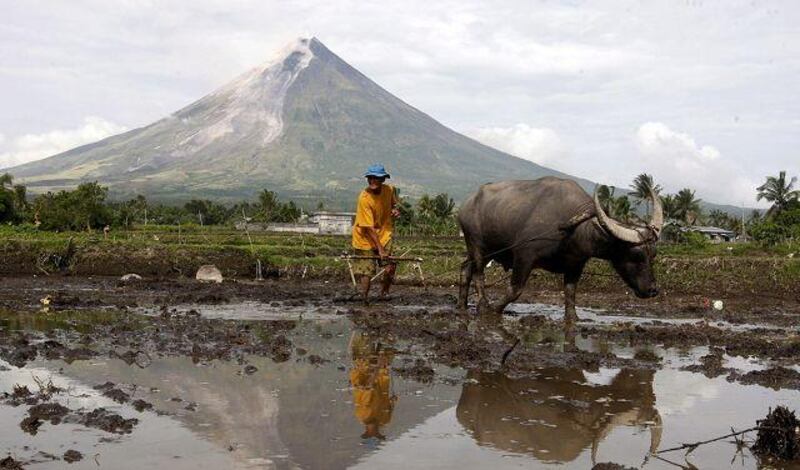Authorities in the Eastern Philippine raced yesterday to complete the forced evacuation of a danger zone around the Mount Mayon volcano after it showed further signs of imminent eruption.
By the middle of the day emergency workers had moved to safety about 29,000 of the nearly 50,000 people in immediate danger - those living within 8km of Mayon, said Joey Salceda, the governor of the surrounding province of Albay. After inspecting the arrangements, the defence secretary, Norberto Gonzales, who is in charge of disaster preparedness and relief nationally, said he was confident that the evacuation would be finished by the end of the day. Earlier, Mr Salceda said the authorities hoped to complete the evacuation today.
The volcano continued to spout clouds of ash and steam into the sky and more lava was seen trickling down its flanks, while the ground rumbled with volcanic tremors, the Philippine Institute of Volcanology and Seismology (Phivolcs) said. Local news media reported ash falling in some nearby areas. "If the trend is of increasing unrest, a hazardous volcanic eruption is possible within weeks," a Phivolcs statement warned.
The 2,462-metre volcano, on the main island of Luzon, is the most active in the Philippines, having erupted more than 40 times since records began about four centuries ago. The surrounding area is mostly agricultural. In daylight, the summit was obscured by clouds of ash or steam. At night, thin streams of glowing lava lit the slopes. The authorities ordered the evacuation of the danger zone on Monday after Phivolcs increased its alert for Mayon to Level Three. A Level Four alert would mean an eruption could occur within days, and a Level Five alert would mean an eruption is in progress.
Phivolcs' chief volcanologist, Renato Solidum, said a major eruption might mean a further 75,000 people would have to flee. The authorities brought in military lorries to help in the evacuation. Those displaced are being sheltered in schools and other buildings outside the danger zone. They are being given food and water. The provincial governor said tents were being set up as temporary classrooms so displaced children's education could continue.
The residents displaced are generally Christians, like most Filipinos. Mr Salceda said they would probably have to spend Christmas in evacuation centres. He said he had ordered packages of special Christmas food for each family. There were reports in the local media of inadequate sanitation at some evacuation centres. The authorities said their aim was to avoid any deaths at all during Mayon's current bout of activity. Their evacuation plan has been well rehearsed. The last time the volcano erupted, in 2006, about 30,000 people were moved to safety, and no lives were lost.
The evacuation plan takes into account lessons learnt in the previous eruption, in 1993, when pyroclastic flows - super-hot, fast-moving currents of volcanic gas and rock - shot down the mountainsides, killing at least 77 people. In 1993 one of the problems the authorities faced was the refusal of some residents to leave the danger zone. Those that refused to go often said they had to stay behind to protect livestock, crops and other property from looters.
Of the residents fleeing yesterday, clutching assortments of possessions they considered valuable or useful, most appeared to be women, children and the elderly. Some said the men had stayed behind to keep an eye on their property, and would follow later. As they fled, Mayon spouted a plume of ash 500 metres into the air above its summit. Phivolcs said lava had trickled 800 metres down the slopes of the mountain. The frequency of volcanic tremors is well above average, meaning more magma, or molten rock, was moving up inside Mayon towards its crater, Phivolcs said. One volcanologist said Mayon could behave like this for months.
If the refugees have to stay in evacuation centres that long, or if a big eruption swells their number, the authorities may face new problems. The Albay provincial chief of police, William Macavinta, said the evacuation centres would have enough food and water for only 18 days. The provincial governor has said he will appeal for international aid, if necessary.
In the event of overcrowding, the authorities may also have to deal with outbreaks of disease in the centres. Even when the residents return home, they may face new danger - and not necessarily from an eruption. Shortly after the 2006 eruption, a typhoon poured torrential rain onto the slopes of Mayon, dislodging volcanic debris that had collected during the eruption and washing it down onto the villages below. The landslides killed an estimated 1,000 people who thought they were safe.
The volcano's most deadly eruption on record was in 1814, when it buried an entire town, killing more than 1,200 people. @Email:foreign.desk@thenational.ae





